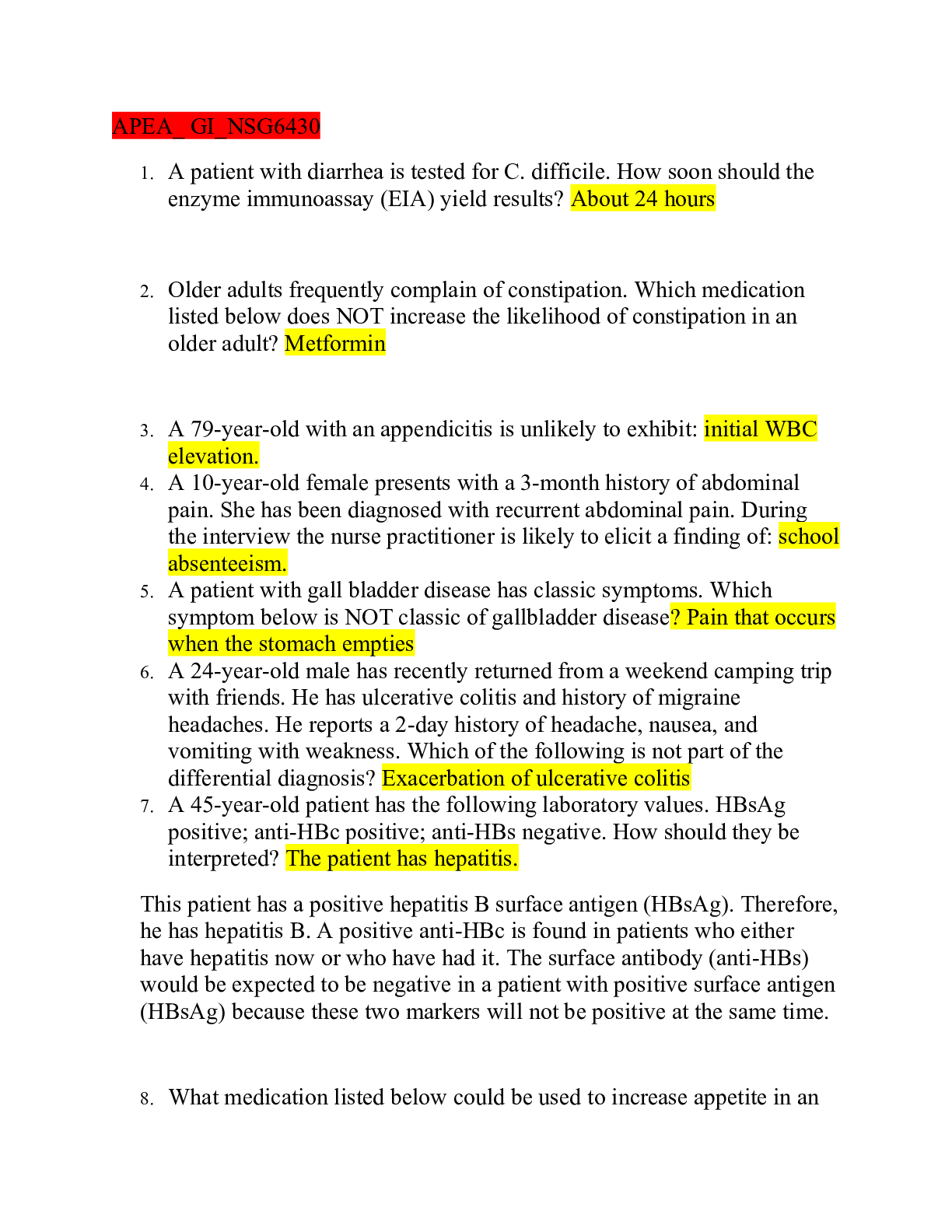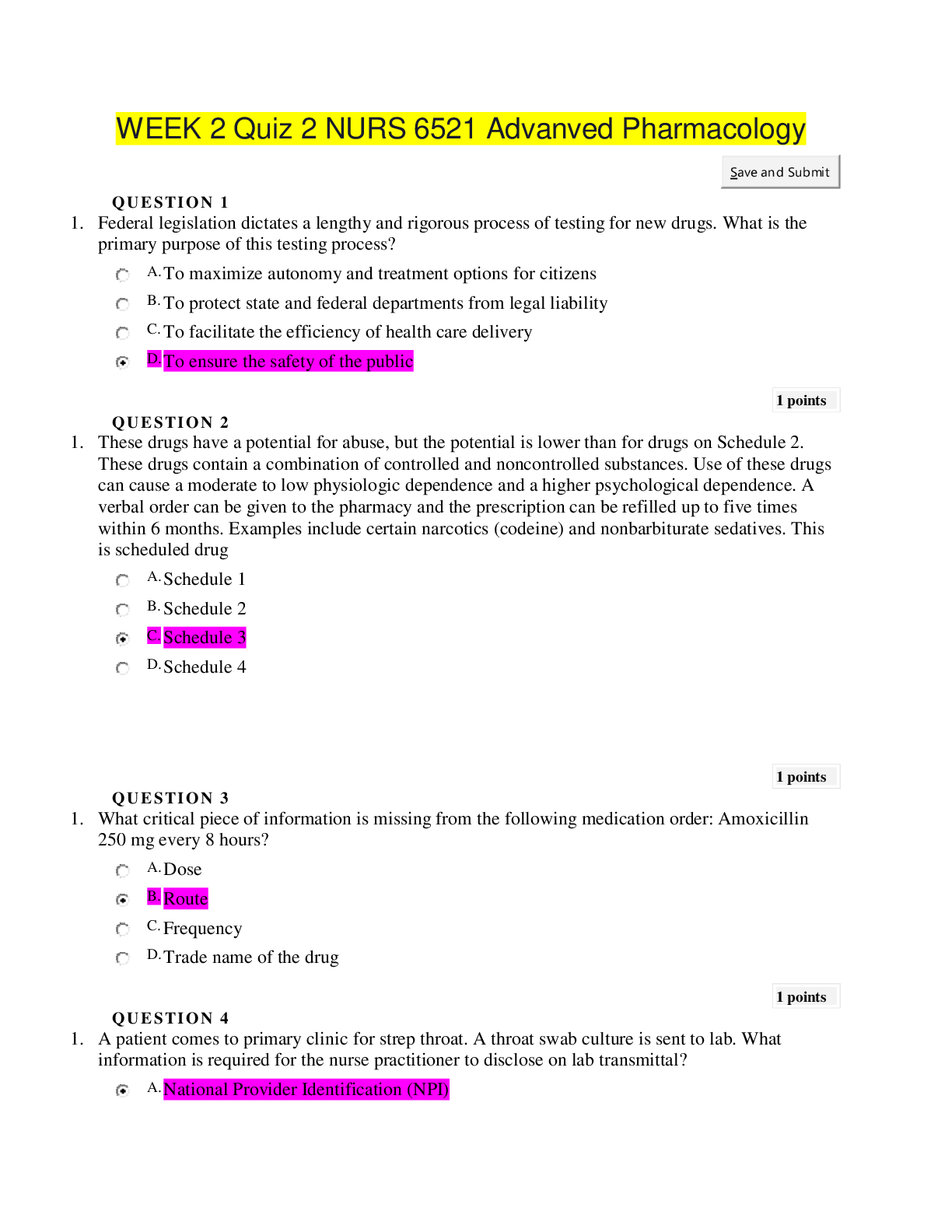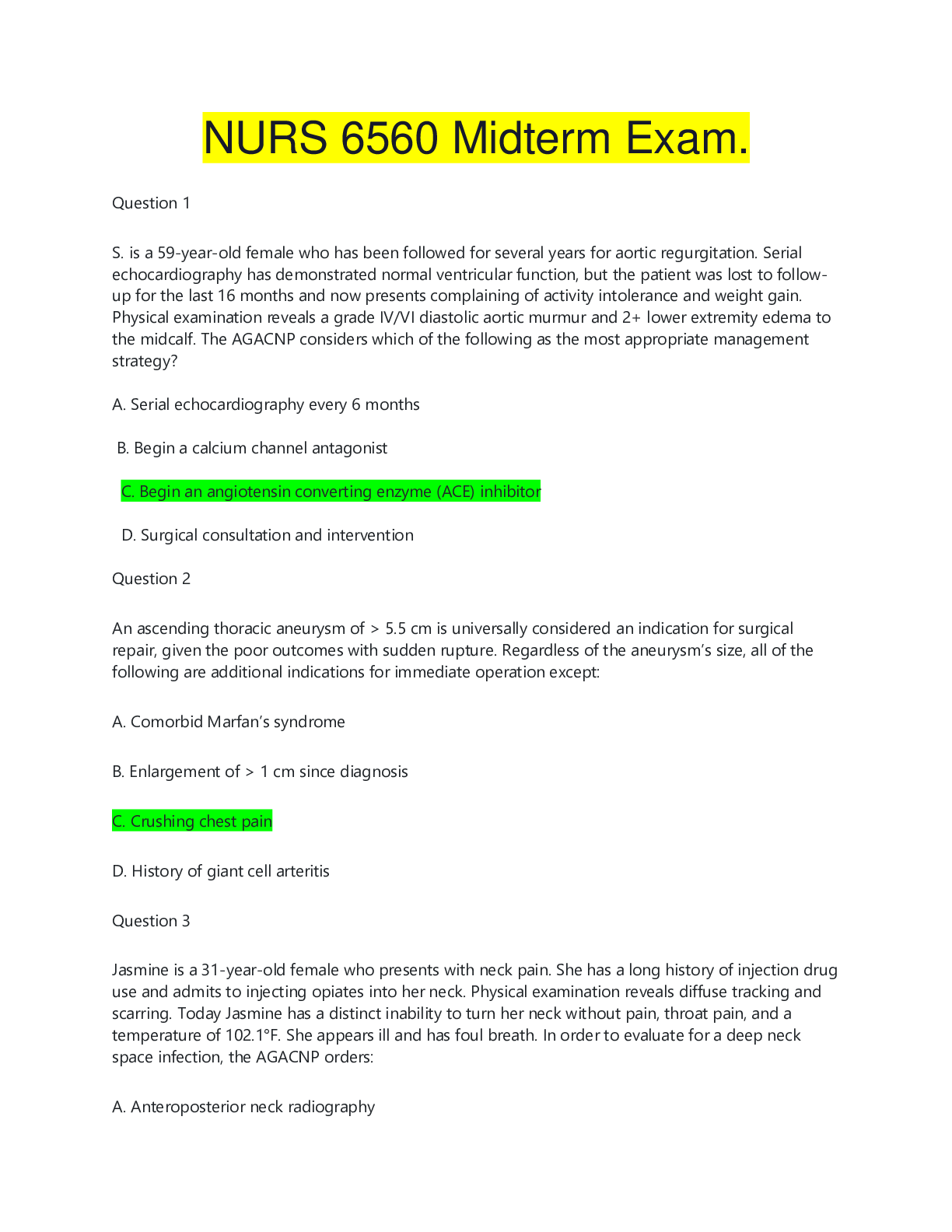Biology > EXAM > SCIN130 /SCIN 130 Introducton to Biology quiz 4 (GRADED A) Questions and Answers | Download To Score (All)
SCIN130 /SCIN 130 Introducton to Biology quiz 4 (GRADED A) Questions and Answers | Download To Score that A
Document Content and Description Below
SCIN130 /SCIN 130 Introducton to Biology quiz 4 Quiz 4 Comment:For feedback on the short answer question and lab, please see the specific question. Part 1 of 8 - Part 3: Lab ELF 9.0 Points Q... uestion 1 of 31 3.0 Points Which type of variable does not change during an experiment, and serves as a comparison point for all data points? • A. dependent • B. random • C. independent • D. control Feedback:Correct! There has to be one variable in the experiment that researchers compare the results of the experiment to, so that accurate conclusions can be made. Question 2 of 31 3.0 Points What is the independent variable in the following hypothesis: bacterial growth in an incubator may be affected by temperature? • A. bacterial growth • B. incubator • C. the affect • D. temperature Feedback:The independent variable is the thing that changes in the experiment, and the dependent variable is what is being measured. Review Relating the Hypothesis to the Experiment in the Lab Lesson Content. Question 3 of 31 3.0 Points What is the phenomenon when a fake treatment improves a patient’s condition simply because he or she expects that it will help, but not that it is helping? • A. positive result • B. placebo effect • C. control group • D. sample size Feedback:When one believes a treatment helps, but the treatment is not an actual drug, the effect is due to an inactive substance. Review the Placebo Effect in the Lab Lesson Content. Part 2 of 8 - Chapter 7 18.0 Points Question 4 of 31 3.0 Points Meiosis produces daughter cells that are what? • A. used to replace dead or damaged cells in the body • B. functionally different in different parts of the body • C. for growth of the body • D. sexual reproduction Feedback:Great job. Question 5 of 31 3.0 Points The most common human trisomy is that of chromosome 21, which leads to what? • A. Cri-du-chat syndrome • B. Angelman syndrome • C. Down’s syndrome • D. Klinefelter syndrome Feedback:Great job. Question 6 of 31 3.0 Points What is an individual with an incorrect number (2n-1 or 2n+1) of chromosomes called? • A. autosome • B. euploid • C. aneuploid • D. polyploid Feedback:Great job. Question 7 of 31 3.0 Points Humans would best be described as having which of the following life cycles? • A. diploid-dominant • B. alternation of generations • C. haploid-dominant • D. gametophyte dominant Feedback:Great job. Question 8 of 31 3.0 Points Fungi would best be described as having which of the following life cycles? • A. diploid-dominant • B. alternation of generations • C. gametophyte dominant • D. haploid-dominant Feedback:Great job. Question 9 of 31 3.0 Points Tortoise shell cats have variegated coat colors caused by X inactivation and are always what? • A. homozygous females • B. heterozygous males • C. heterozygous females • D. homozygous males Feedback:Great job. Part 3 of 8 - Chapter 8 18.0 Points Question 10 of 31 3.0 Points Mendel made crosses between parental lines of pea plants that were homozygous for different alleles of the traits he was studying. When crossing two parents, the F1 generation were all what? • A. recombinants • B. homozygous recessive • C. heterozygous • D. homozygous dominant Feedback:Great job. Question 11 of 31 3.0 Points What are gene variants at the same relative locations on homologous chromosome? • A. alleles • B. linked • C. homozygotes • D. codominant Feedback:Great job. Question 12 of 31 3.0 Points What is incomplete dominance? • A. when in a heterozygote, expression of two contrasting alleles such that the individual displays an intermediate phenotype • B. a phenomenon in which alleles that are located in close proximity to each other on the same chromosome are more likely to be inherited together • C. in a heterozygote, one trait will conceal the presence of another trait for the same characteristic • D. an interaction between genes such that one gene masks or interferes with the expression of another Feedback:Great job. Question 13 of 31 3.0 Points In humans, which of the following is not a sex-linked conditions? • A. some forms of color-blindness • B. hemophilia • C. left or right handiness • D. muscular dystrophy Feedback:Great job. Question 14 of 31 3.0 Points In a cross between two heterozygous (Aa) individuals, what is the likely percentage of the offspring that will be heterozygous? • A. 75% • B. 50% • C. 100% • D. 25% Feedback:Great job. Question 15 of 31 3.0 Points How many unique gametes could be produced through independent assortment by an individual with the genotype AABbCC? • A. 2 • B. 4 • C. 8 • D. 1 Feedback:A gamete would receive one copy of each allele – meaning either A or A, B or b, C or C – and the combination is what we are looking for. Review Chapter 8. Part 4 of 8 - Lecture ELF 9.0 Points Question 16 of 31 3.0 Points What is the purpose of a Punnett Square? • A. it is a way to visualize only the phenotype in a population • B. it is a way to visualize only the genotype of a cross • C. it is a way to visualize the chromosomes in a population • D. it is a way to visualize the phenotype and genotype of a cross Feedback:Mendel used a Punnett Square to determine what the peas looked like, both in color as well as genetically. Review the Punnett Square in the Weekly Lesson Lecture. Question 17 of 31 3.0 Points What is the central dogma of molecular biology? • A. Proteins can reproduce unassisted • B. Proteins cycle through the cell, ending in RNA coiling • C. RNA initiates DNA replication, which controls all aspects of life • D. DNA is read by RNA, which is then read and proteins are produced Feedback:DNA is the storage material for all traits, and is the beginning of all processes. Review the Central Dogma of Molecular Biology in the Weekly Lesson Lecture. Question 18 of 31 3.0 Points What can cause both helpful changes in our DNA sequence, such as an adaptation, as well as harmful ones, such as cancer? • A. mutations • B. heterozygote • C. replication • D. dominant Feedback:Changes in our DNA can occur through chance, and the products can either help an individual adapt, or cause harmful effects such as cancer. Review DNA Replication in the Weekly Lesson Lecture. Part 5 of 8 - Chapter 6 18.0 Points Question 19 of 31 3.0 Points Which type of human cells contain a half set of chromosomes (often written as n)? • A. chromosome • B. gamete • C. nucleus • D. genome Feedback:Sex cells are referred to at haploid, as they only have half of the number of chromosomes. Review the genome in Chapter 6. Question 20 of 31 3.0 Points What is the purpose of checkpoints in the cell cycle? • A. to maintain protein health in the cell • B. to ensure detrimental mutations are not passed on • C. to keep any foreign DNA out of the cell • D. to make the division move faster Feedback:Great job. Question 21 of 31 3.0 Points What is the process of cell division called in prokaryotes? • A. Cytokinesis • B. Binary fission • C. Double fusion • D. Single mutation Feedback:Great job. Question 22 of 31 3.0 Points What is the phase that not all cells enter, but is a phase where cells are not actively dividing? • A. S • B. G0 • C. G1 • D. G2 Feedback:Some cells, either temporarily or permanently, are in a quiescent stage when they exit the cell cycle. Review the cell cycle in Chapter 6. Question 23 of 31 3.0 Points During which stage in interphase does DNA synthesis occur? • A. Mitosis • B. G2 phase • C. S phase • D. G1 phase Feedback:Great job. Question 24 of 31 3.0 Points What is the major difference during cytokinesis in eukaryotes with or without a cell wall? • A. cleavage furrow in those without cell walls • B. cytokinesis does not occur in cells without a cell wall • C. cell plate in those without cell walls • D. cytokinesis does not occur in cells with a cell wall Feedback:The cell wall means that cell division occurs with an additional structure, resulting from vesicles fusing on the cell wall. Review the cell cycle in Chapter 6. Part 6 of 8 - Lab Material 15.0 Points Question 25 of 31 3.0 Points What was a big different between the fossils in layer 5 and those in layer 2? • A. Layer 2 contained mostly fish without spines • B. Layer 5 contained mostly fish without spines • C. Layer 5 had fish that were mostly female • D. Layer 2 had fish that were mostly female Feedback:Review Lab 4: Stickleback Evolution, Part 2 Question 26 of 31 3.0 Points What score would you assign to a fossil specimen that has only one pelvic spine visible? • A. complete • B. reduced • C. semi-absent • D. absent Feedback:Great. Question 27 of 31 3.0 Points How many years separation does each layer in this fossilized stickleback lab represent? • A. 1 billion • B. 3,000 • C. 1 million • D. 10,000 Feedback:Great. Question 28 of 31 3.0 Points Why did we use a line graph for the data in this experiment? • A. It is the only type where time can be added • B. They are used to represent continuous data • C. They have an X and Y axis • D. You can compare one point in time Feedback:Great. Question 29 of 31 3.0 Points What is one advantage to studying fossils? • A. There are no advantages to fossils • B. We can see long-term patterns • C. We can alter current evolution • D. There is indication of what is occurring in real-time Feedback:Great. Part 7 of 8 - Lab Essay 5.0 Points Question 30 of 31 5.0 Points In 2-3 sentences, what was the overall purpose of the lab for this week? The overall objective of experiment 2 is to see which stickle cell fish has complete, reduced, or absent pelvic by examining fossils from two different lakes. Comment: you are on the right track, but what can we learn from that bone? The purpose of the lab is to examine the Stickleback fish's pelvis over time. It presence or absence of the pelvis tells of the environment during that time in it's history, and how the species have evolved over time. Part 8 of 8 - Lab Upload 8.0 Points Question 31 of 31 8.0 Points Please upload your completed Lab Packet for this week. Make sure your name is on the top in the space provided. [Show More]
Last updated: 2 years ago
Preview 1 out of 23 pages

Buy this document to get the full access instantly
Instant Download Access after purchase
Buy NowInstant download
We Accept:

Reviews( 0 )
$11.00
Can't find what you want? Try our AI powered Search
Document information
Connected school, study & course
About the document
Uploaded On
Sep 24, 2021
Number of pages
23
Written in
Additional information
This document has been written for:
Uploaded
Sep 24, 2021
Downloads
0
Views
54



 Questions and Answers 100% VERIFIED.png)
 Questions and Answers 100% correct Solutions.png)






.png)














